Workforce Digest: Not Cold But Cooling
A deeper dive into the workforce

⬇️ 2.6% workforce growth rate in October 2023. This is slightly lower than the workforce growth rate in September (2.7%). The hiring rate remained unchanged through October, but the attrition rate ticked up slightly.
⬇️ 40.4% of workers who started a new job in October transitioned to a new role and 67.5% transitioned to a new industry. Construction had the largest increase in the share of workers coming from other industries.
⬇️ 2.97% decrease in active job listings in October from September. The decrease in demand for workers was the largest in Management, Administrative Support Services, and Construction.
⬆️ 43.5 days to fill job openings. This is 3.8 days more than in September 2023 and 2.7 days fewer than in October 2022. IT specialist roles were the hardest to fill in October.
⬇️ 16.7% decrease in the number of employees notified of layoffs under the WARN Act compared to September 2023.
November's Jobs Report is below expectations
The unemployment rate ticked up to 3.9% in October. The US economy added 150,000 jobs in October, falling short of the expectations. Job gains were largely driven by the Healthcare and Social Assistance and the Government sectors. On the other hand, the Manufacturing sector recorded net job losses, especially in the motor vehicles and parts industry, which was significantly affected by ongoing auto strikes.

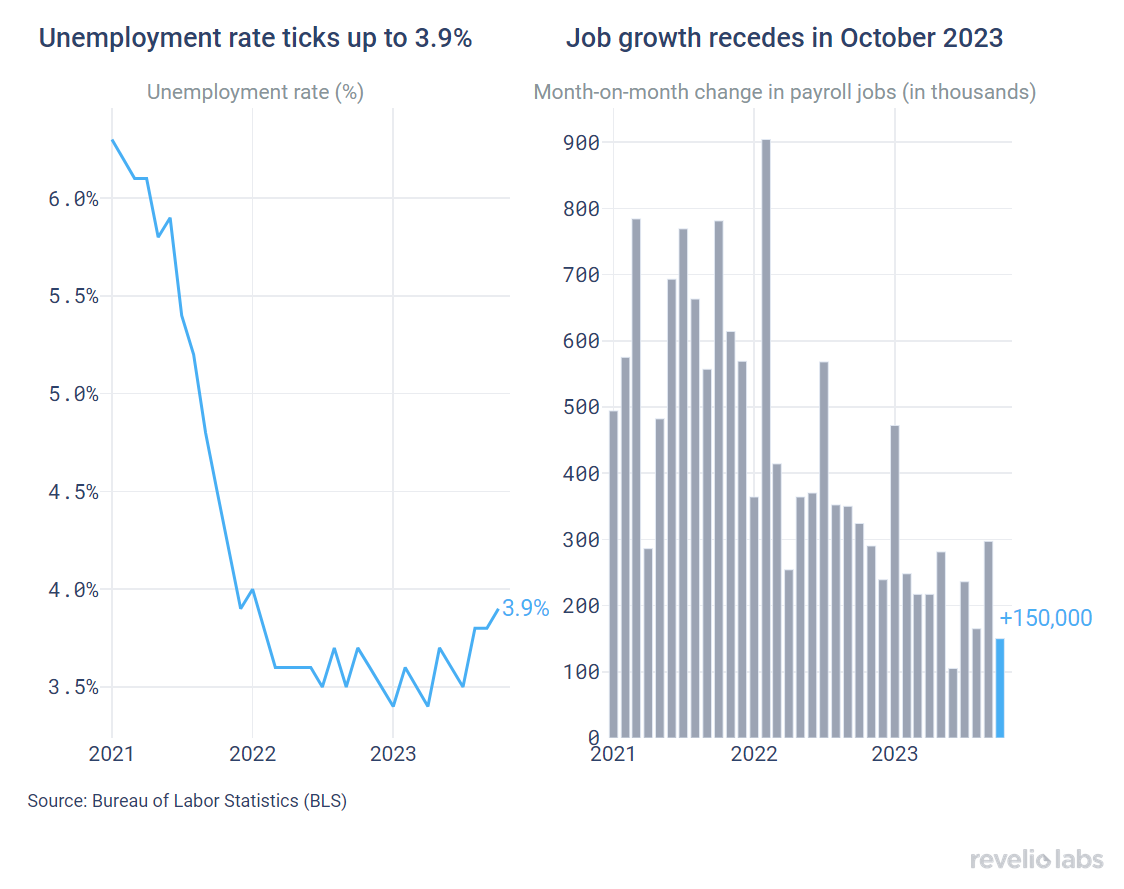
What does the granular workforce data from Revelio Labs have to say about the labor market, and what do they signal about the labor market in the near future?
Stable hiring and attrition rates
Revelio Labs' workforce intelligence data show that hiring and attrition rates have been stable in October. The hiring rate stood at 18.7% (same as the rate in September) and attrition rate stood at 16.1% (compared to 16% in September). The workforce growth rate (difference between hiring and attrition rates) stood at 2.6% (0.1 percentage points less than September on a m.o.m basis).

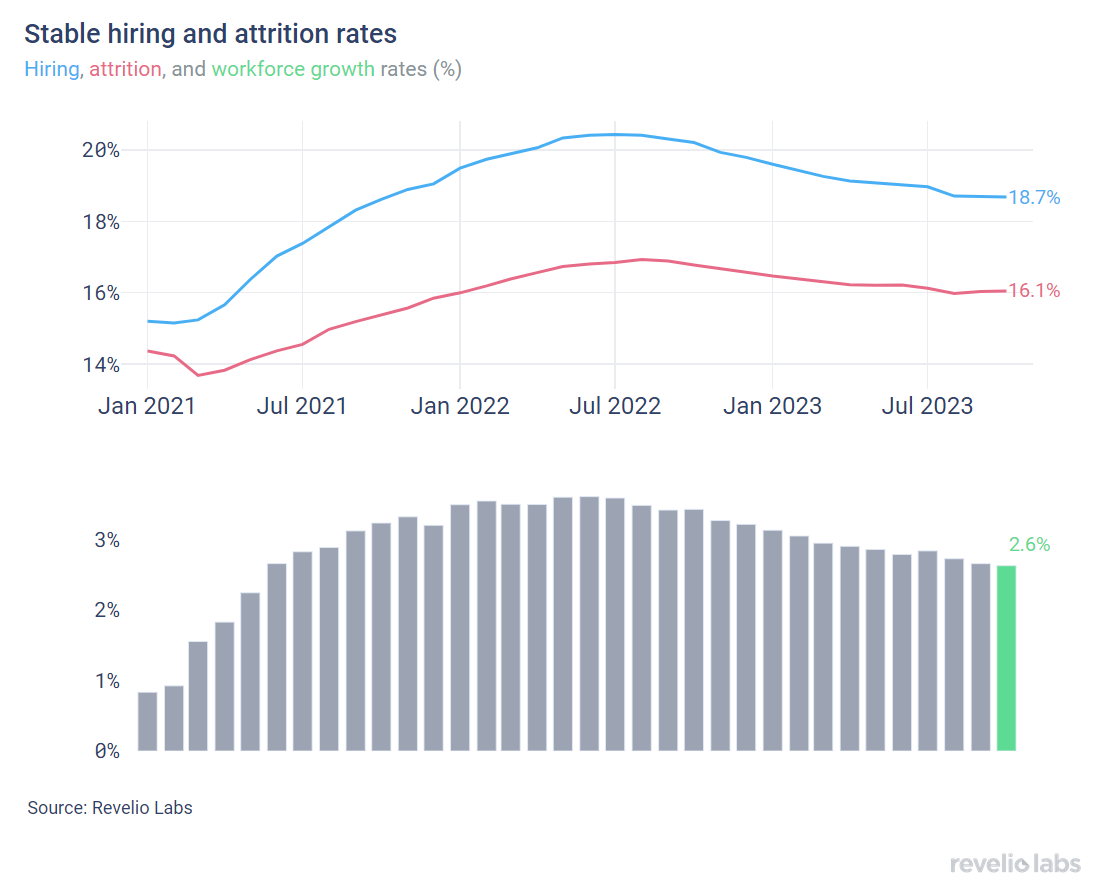
Hiring and attrition have continued to slow down in all sectors, although the degree of slowdown varies. Compared to September 2023, hiring in many sectors was unchanged. Yet, the Education sector experienced the largest decline in hiring (-0.3 pp). Professional Services and Administrative and Support Services had the largest increase in attrition relative to September (0.3 pp).

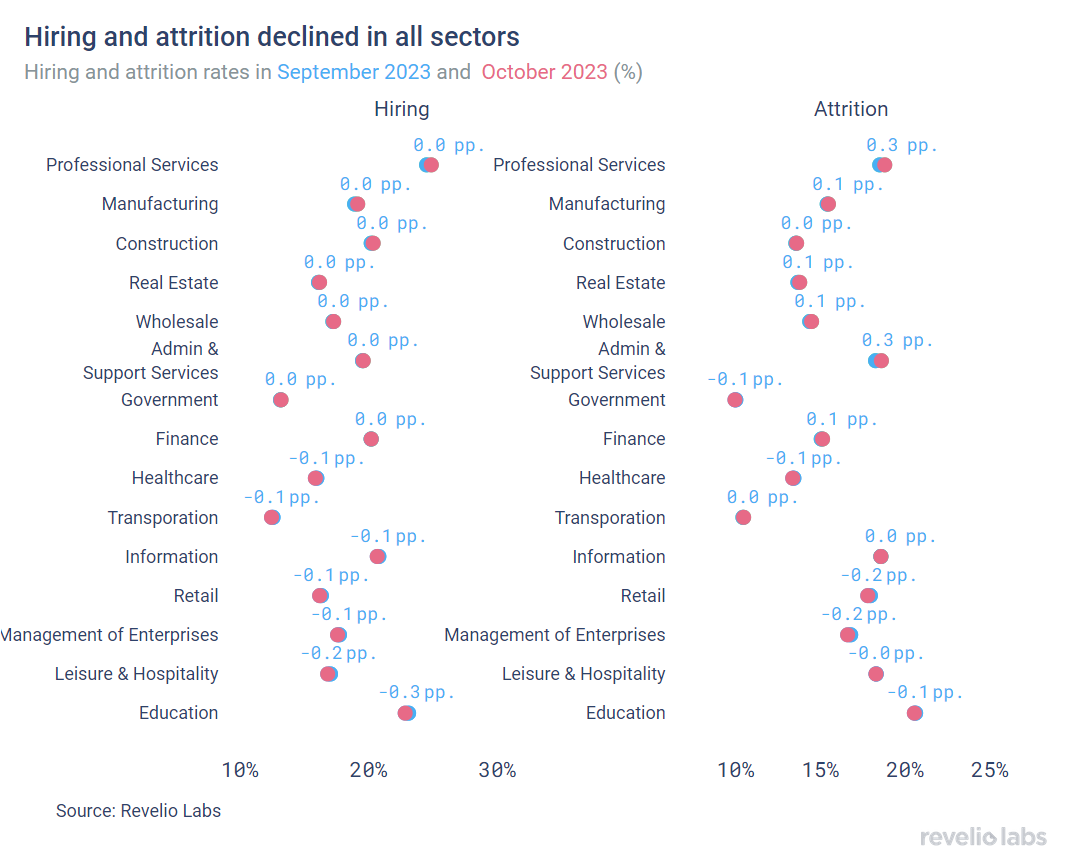
Of those who started a new job in October, 40.4% have transitioned to different roles and 67.5% have switched industries. The continued decline in mobility signals less confidence in the labor market.
Using Revelio Labs' extensive workforce intelligence data on millions of employee profiles in the US, we track workers' transitions between industries and occupations. Our analysis shows that 40.4% of workers who started a new job in October did so by also switching their broad job categories; unchanged from the 40.4% observed in September. Furthermore, 67.5% of workers who started a new job in October, started jobs in different industries. The consistent decline in the rate of switching industries and job categories since the beginning of 2023 signals weaker opportunities for participants in the labor market.

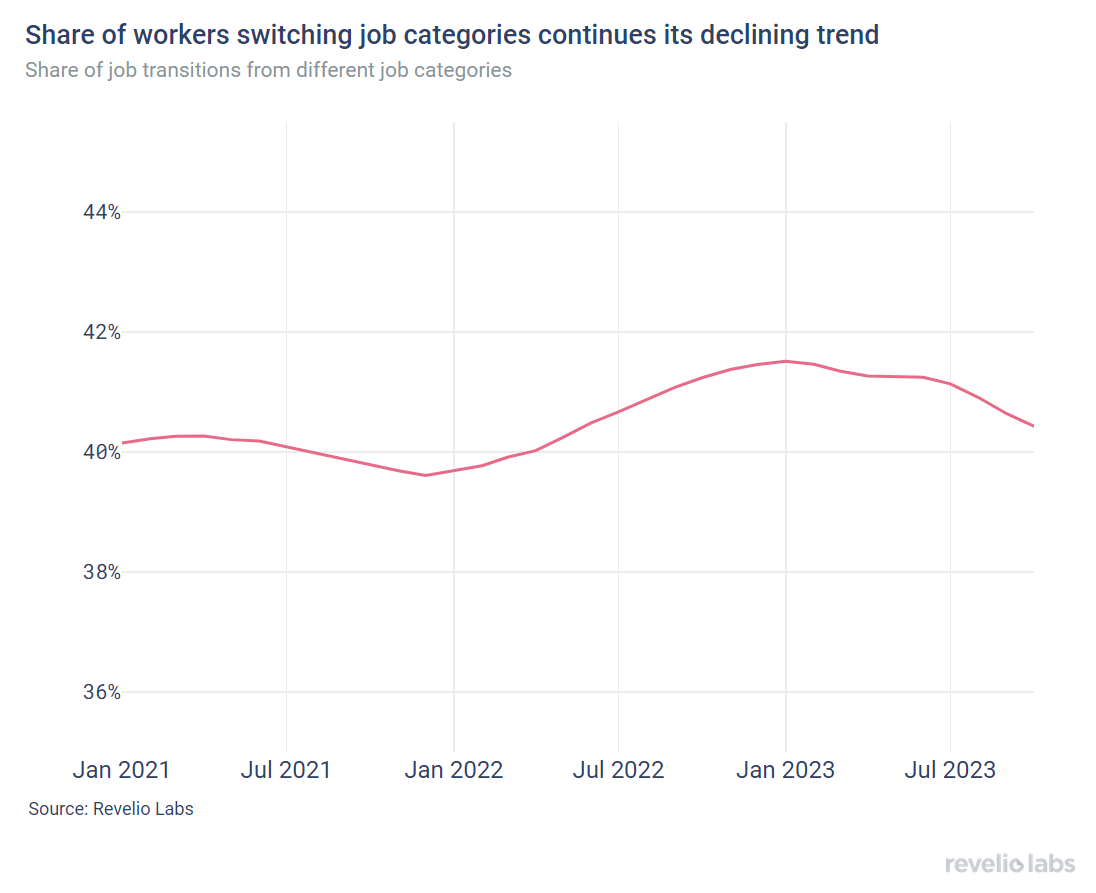
Next in this job report, we analyze industry and role switches in positions in October. The left panel in the figure below shows the difference in the share of workers who switched to a different industry, relative to September 2023. Notably, Construction industry had a substantial increase in the influx of workers from other industries. 81.8% of workers who started a job in Construction in October came from other industries, relative to 76.2% in September 2023 (+5.6 percentage points). In contrast, the Information industry experienced the largest decline in the share of workers joining the industry from other industries. 62.1% of workers who started a job in Information in October had backgrounds in other industries, relative to 66.8% in September 2023 (4.6 percentage points decrease).
The right panel shows the difference in the share of workers who started a new job in a different role, relative to August 2023. Quality Assurance and operations roles exhibited the largest increase in the share of workers transitioning from different roles compared to the previous month, while IT managers witnessed the largest decline.

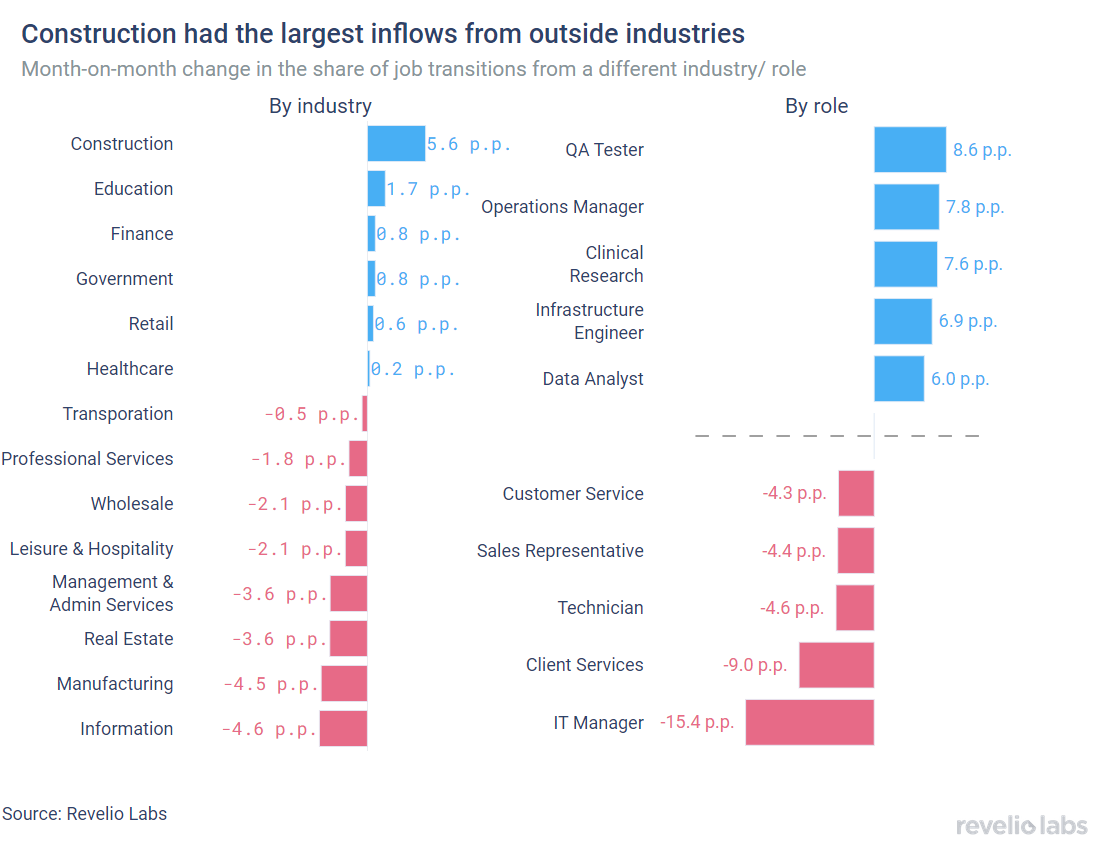
Job postings continued to decrease in October, but the time-to-fill ticked up
In October, the active job postings index , which had already experienced a significant drop in September, continued its downward trend. Job listings saw a 2.97% decrease compared to the previous month, following a 3.8% decrease in September. Notably, this decline brought the active job postings index to its lowest level since the beginning of the year.

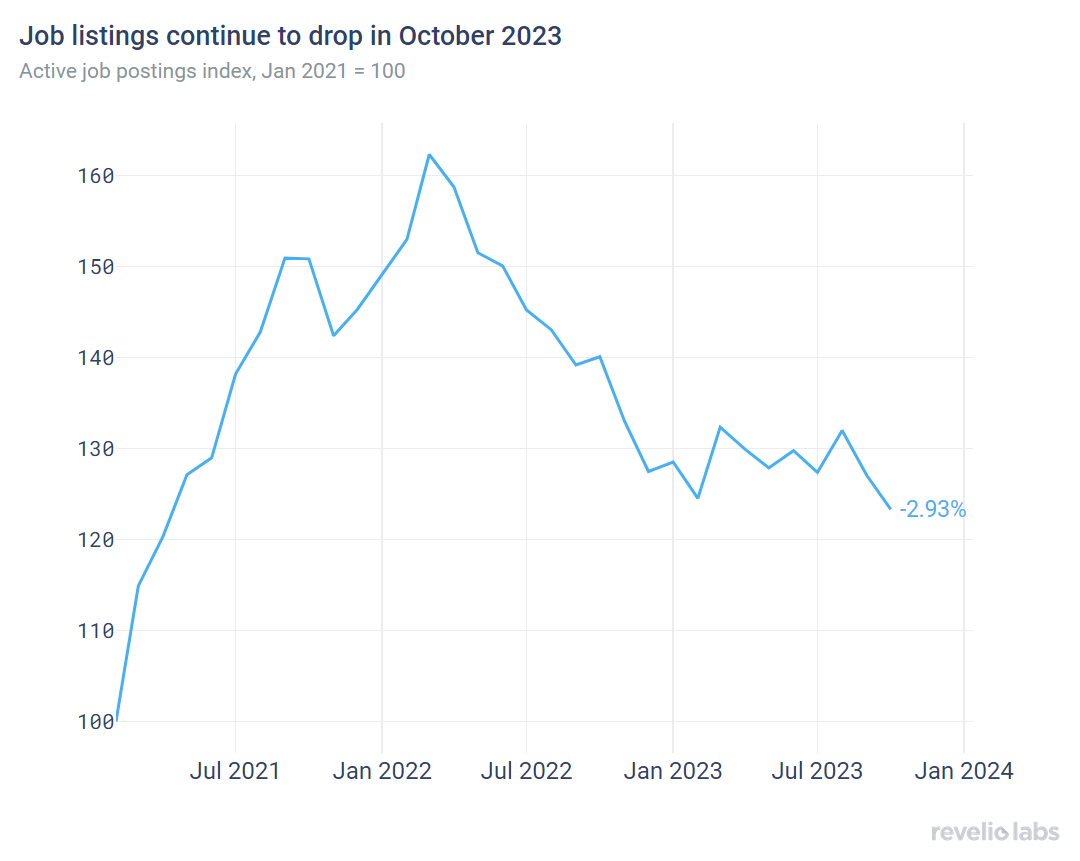
The substantial decline in job listings in October suggests a widespread reduction in workforce demand across industries. The decrease in job postings was the largest in Management and Administrative Support Services, which was the only industry that experienced a modest uptick in job listings in September. The Construction industry, on the other hand, recorded the largest increase in the demand for workers, with active job listings increasing by 7.5% during October.
Following an upsurge in August, demand for customer services continued to decrease in September and October. Few roles had weakly higher demand in October, including factory workers and scientists.

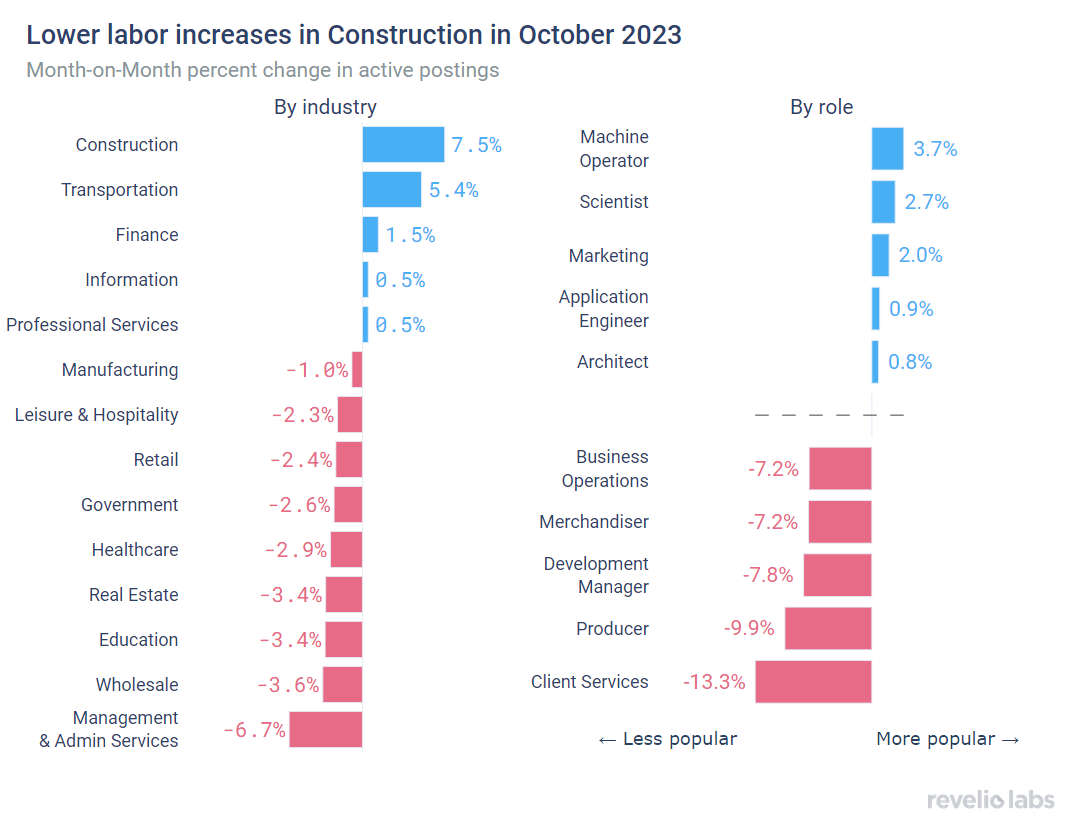
The time-to-fill for open listings continued its downward trend as the labor market continued to slacken. Average days-to-fill stood at 43.5 days in October compared to 39.75 days in September 2023 (+3.78 days).

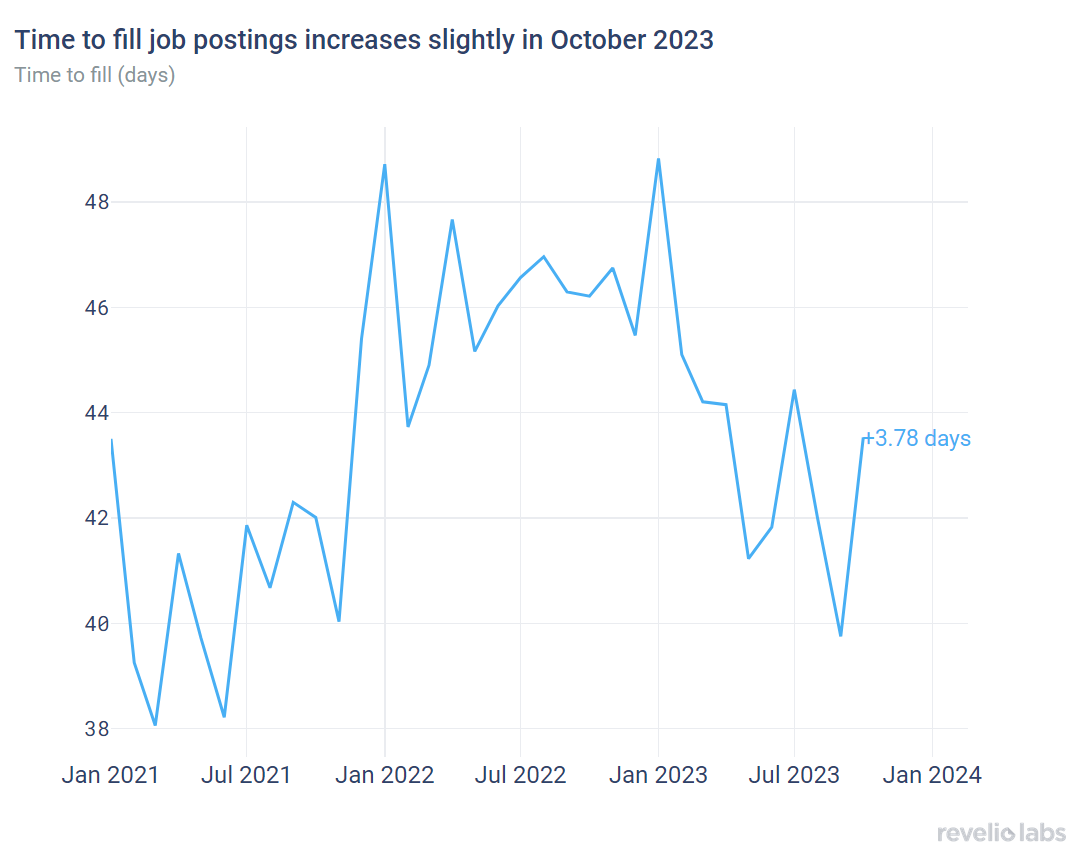
In October 2023, time to fill IT roles more than doubled compared to September (+109.5%). Other roles with large increases in time-to-fill include customer service and human resources. In contrast, filling retail roles was relatively less difficult, with an 11% decrease in the time to fill compared to September.

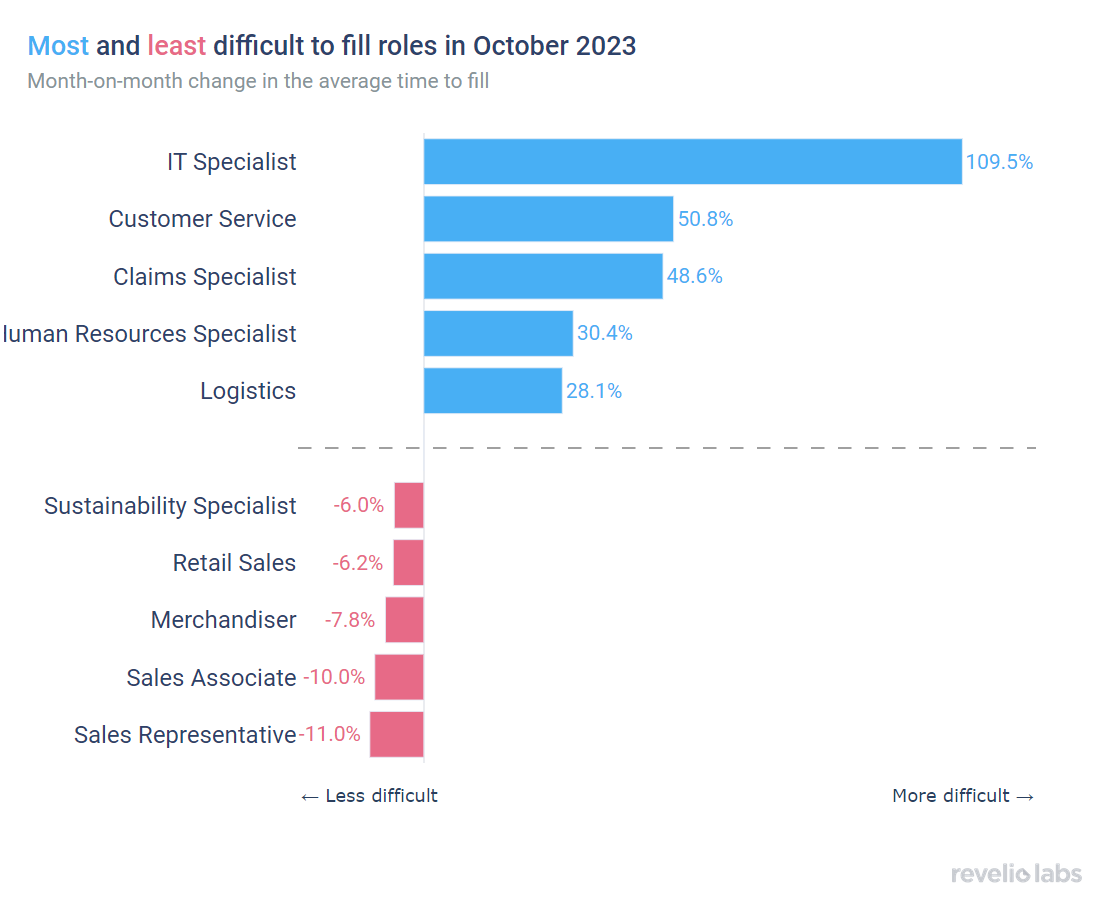
Layoffs continued to decrease in October
The number of employees receiving layoff notices under the WARN Act continued to decrease in October. After a notable decrease in layoffs in August and September, the month of October saw a large decline in both the number of layoff notices and the number of employees notified of layoffs. While the number of layoffs remains highly elevated compared to the Fall of 2022, October layoff notices were the lowest during 2023.

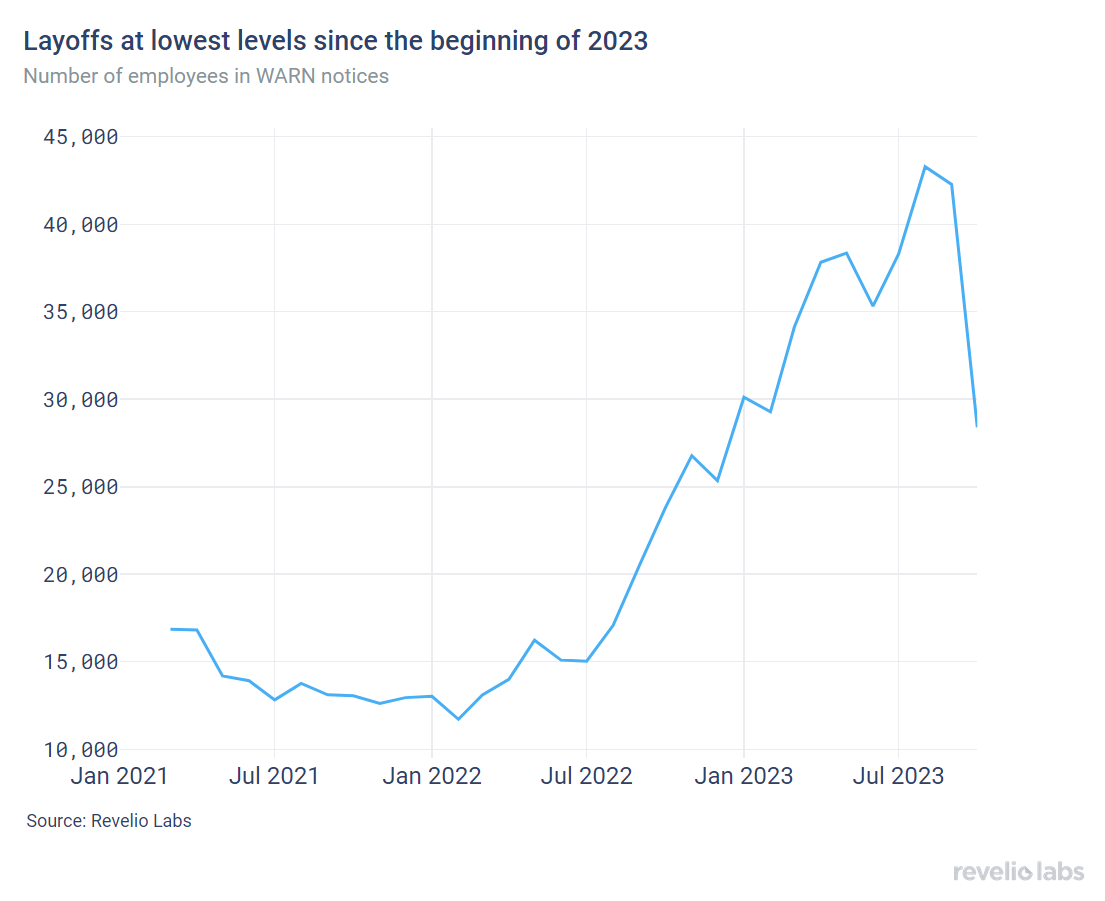
What are workers in America talking about this month?
By examining thousands of employee reviews posted in October, we picked the most common topics that appeared in positive and negative reviews relative to September. In October, workers continue to be positive about people. They are also positive about benefits and culture. Yet, employees continue to be more negative about their hours and management. Workers also complained about the office; probably the result of return to the office mandates, which may have negative implications on their work-life balance.
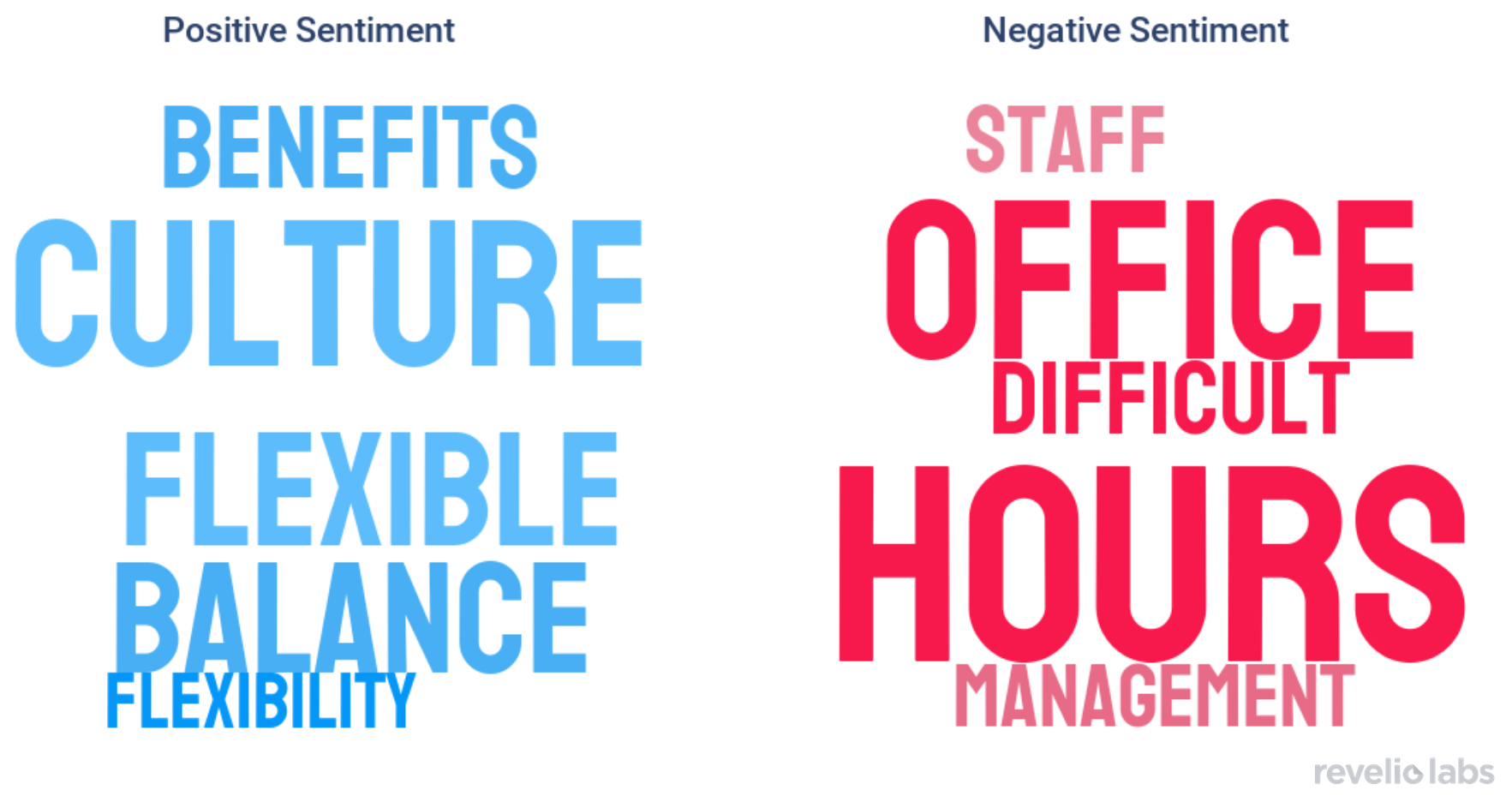
Highlight of the Month: Ghosting!
As the labor market continues to slacken, we take a look at job postings and assess whether job postings represent demand for "real" jobs in the current labor market. In our recent research collaboration with Bloomberg, we can match job postings to new positions that started within 6 months of the posting date to assess which fraction of job postings represent real demand for workers. We find that since 2020, the hires-to-posting ratio has been decreasing; it has decreased at a faster rate in 2023. In 2023, the hires-to-postings ratio is below 0.5 - only half the job postings in 2023 have resulted in actual hires.

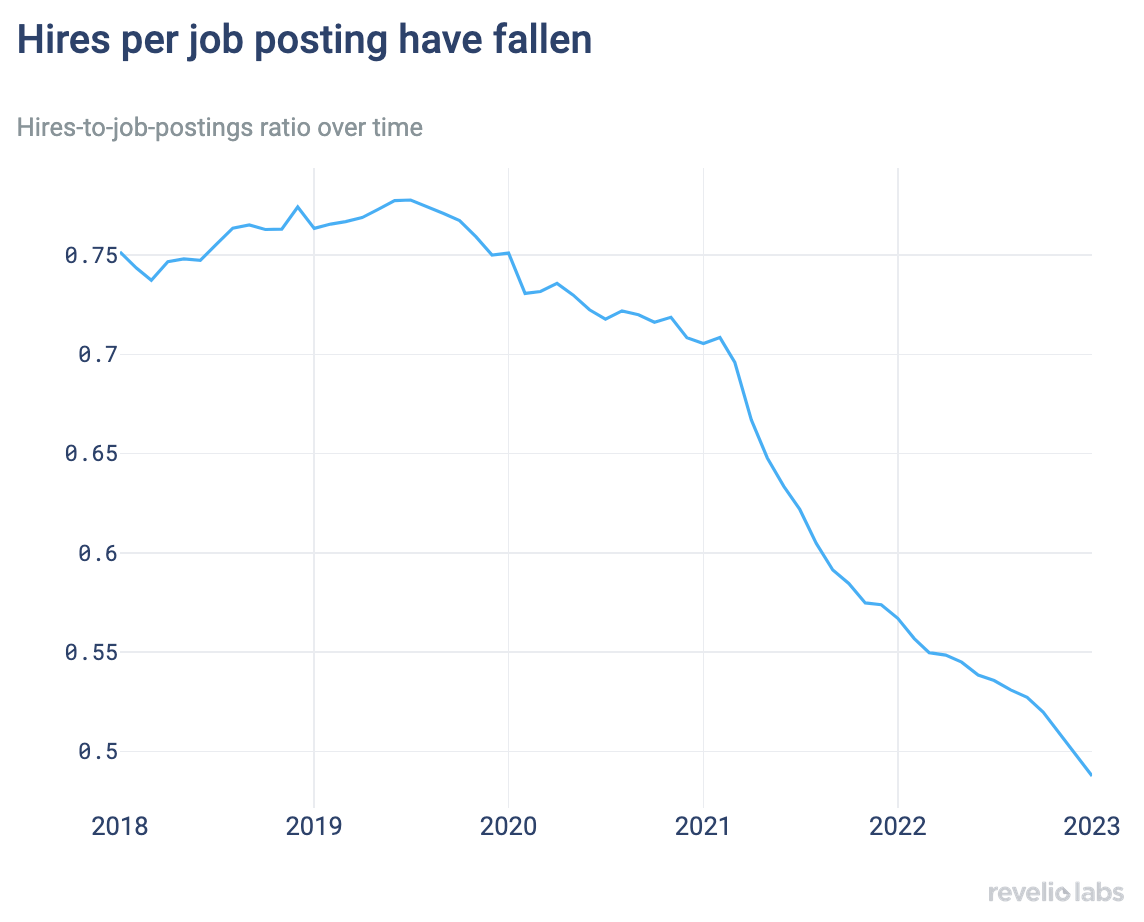
Conclusion
Our read of this month's workforce intelligence data points to some interesting conclusions: (i) there seems to be fewer job transitions in the market as evidenced by constant hiring and attrition rates, largely stable unemployment rate, and declining labor force participation;(ii) confidence in the labor market is declining as we observe workers switching occupations and industries at a slower rate; (iii) job listings continue to decrease, indicating declining confidence by companies. This month, the weak job growth, along with slightly higher unemployment point to real signs of cooling. Looking ahead, the continued decline in job openings signals further slower hiring and job growth in the months to come.
Please view our data and methodology for this job report here and our recent newsletter on ghost job postings here.


